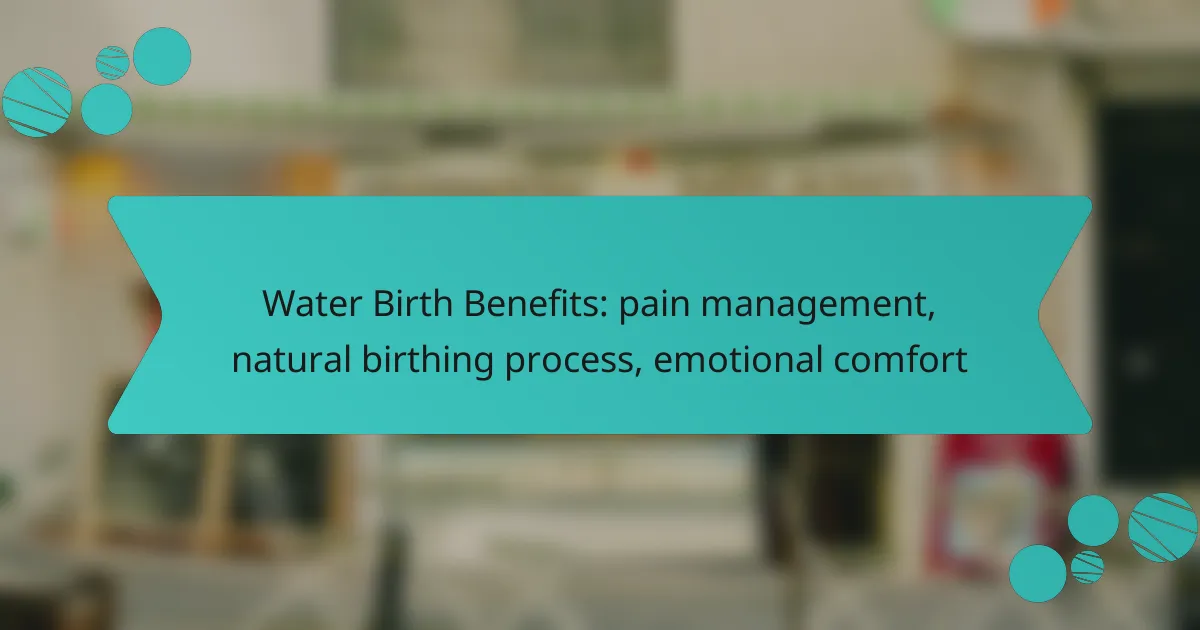Water birth provides a unique approach to labor, enhancing pain management through a soothing environment that promotes relaxation and mobility. This natural birthing process not only alleviates discomfort but also fosters emotional comfort, helping to reduce anxiety and create a more positive experience for the birthing individual.

How does water birth aid in pain management?
Water birth can significantly aid in pain management during labor by providing a soothing environment that helps reduce discomfort. The buoyancy of water allows for greater mobility and relaxation, which can lead to a more positive birthing experience.
Reduced labor pain perception
Immersion in warm water during labor can alter pain perception by promoting the release of endorphins, the body’s natural pain relievers. Many women report feeling less intense pain when laboring in water compared to traditional birthing methods.
Additionally, the warmth of the water can help to relax muscles and ease tension, further contributing to a lower perception of pain. This combination creates a more comfortable atmosphere for the birthing process.
Enhanced relaxation during contractions
Water provides a calming effect that can enhance relaxation during contractions. The warmth and buoyancy allow women to move freely, which can help them find positions that alleviate discomfort.
Many find that being in water helps them focus on their breathing and manage contractions more effectively. This mental and physical relaxation can lead to a smoother labor experience.
Lower need for analgesics
Women who choose water birth often report a reduced need for analgesics, such as epidurals or other pain medications. The natural pain relief provided by water can minimize reliance on pharmaceuticals, which can have side effects.
By utilizing water as a pain management tool, many women experience fewer interventions during labor, promoting a more natural birthing process. This approach aligns with the preferences of those seeking a less medicated experience.
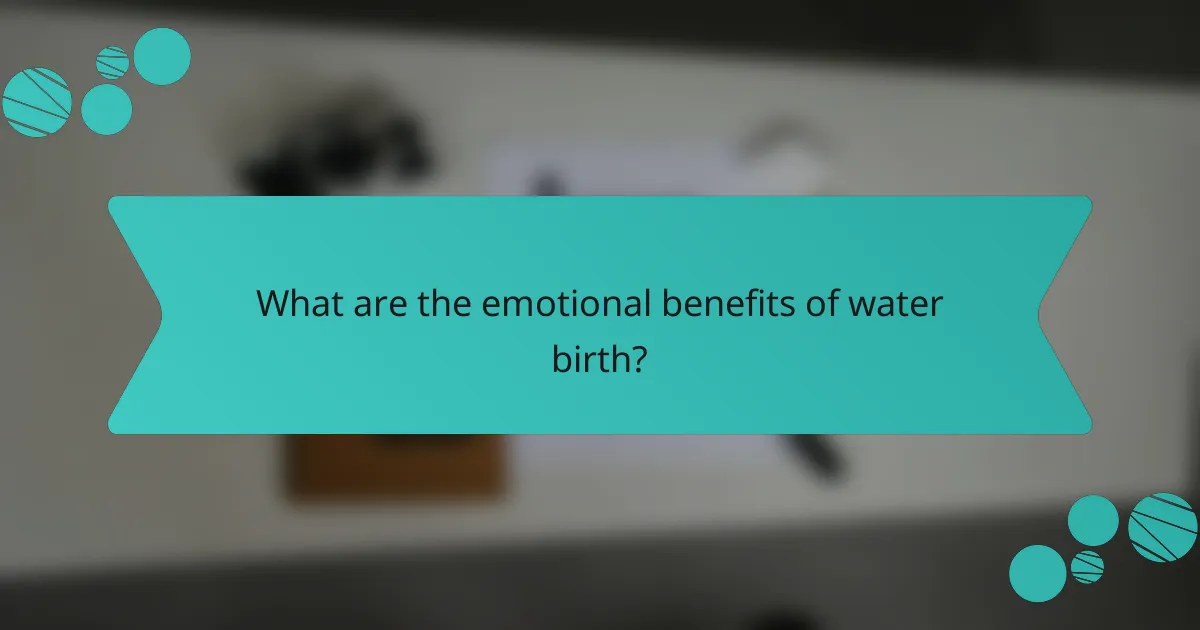
What are the emotional benefits of water birth?
Water birth offers significant emotional benefits, primarily by fostering a sense of calm and comfort during labor. The soothing properties of warm water can help reduce anxiety and promote a more positive birthing experience.
Increased feelings of safety and control
Many women report feeling a heightened sense of safety and control when giving birth in water. The buoyancy of the water can alleviate physical discomfort, allowing mothers to move freely and choose their preferred positions, which can enhance their confidence during labor.
Additionally, the warm water creates a private and intimate environment, reducing distractions and promoting relaxation. This setting can help women feel more empowered and in charge of their birthing process.
Improved bonding experience with the baby
Water birth can facilitate a stronger bonding experience between mother and baby immediately after birth. The gentle transition from water to air can be less shocking for the newborn, allowing for a smoother introduction to the world.
Skin-to-skin contact is often more easily achieved in water, promoting immediate emotional connection. This bonding can lead to increased breastfeeding success and a stronger attachment in the early days of parenthood.
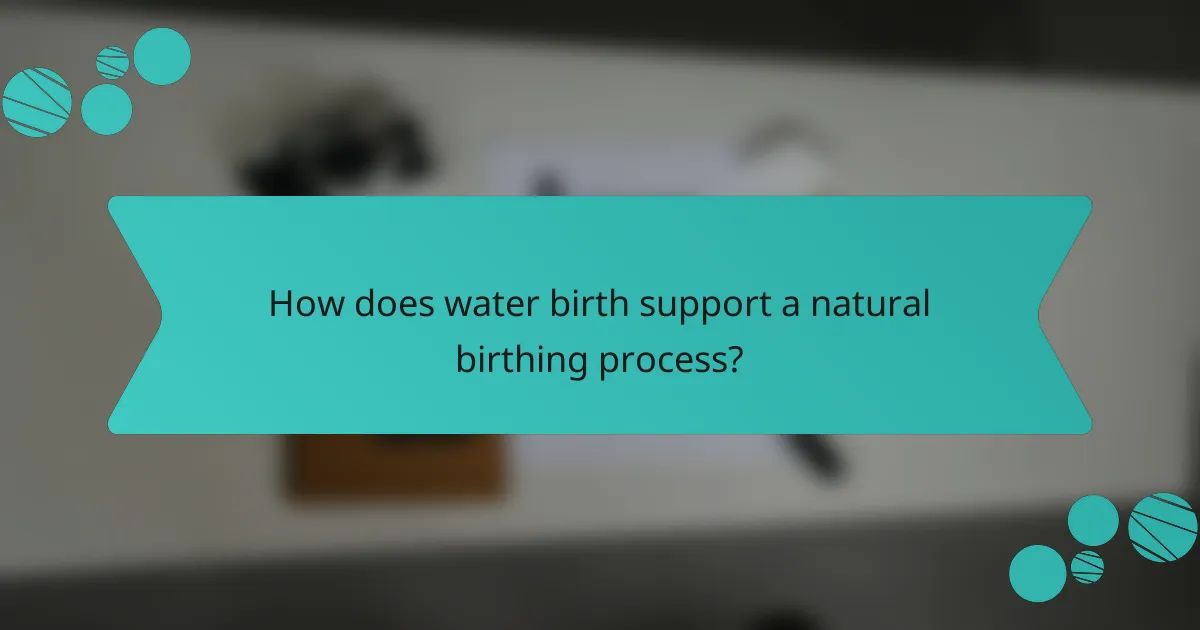
How does water birth support a natural birthing process?
Water birth supports a natural birthing process by providing a soothing environment that can enhance comfort and reduce pain during labor. The buoyancy of water allows for greater freedom of movement, which can facilitate a more instinctive approach to childbirth.
Facilitates natural movement and positioning
Water birth allows mothers to move freely and adopt various positions that feel most comfortable during labor. This freedom can help optimize the baby’s position for delivery, potentially reducing the need for interventions. Common positions include kneeling, squatting, or leaning against the side of the tub.
Additionally, the warm water can help relax muscles, making it easier for the mother to shift positions as needed. This adaptability can lead to a more efficient labor process, as gravity and movement work together to assist in the baby’s descent.
Encourages spontaneous labor
Being in water can create a calming atmosphere that may encourage spontaneous labor. The warmth and buoyancy can help reduce stress and anxiety, which are known to inhibit the onset of labor. Many women find that the soothing properties of water help them feel more in control and connected to their bodies.
It’s important to consider that while water birth can promote spontaneous labor, it may not be suitable for all pregnancies. Consulting with a healthcare provider about individual circumstances and preferences is essential to ensure a safe and positive experience.

What are the prerequisites for a water birth?
To have a water birth, certain prerequisites must be met to ensure safety and comfort for both the mother and baby. These include a thorough health assessment of the mother and the availability of a certified midwife experienced in water births.
Health assessment of the mother
A comprehensive health assessment is crucial before considering a water birth. This evaluation typically includes checking for any medical conditions that may complicate labor, such as high blood pressure or infections. The mother should also be at a low risk for complications during delivery.
Common assessments involve monitoring the mother’s overall health, reviewing her pregnancy history, and ensuring that the baby is in a favorable position for birth. It’s advisable to have this assessment conducted by a healthcare professional familiar with water birth practices.
Availability of a certified midwife
Having a certified midwife present is essential for a safe water birth. Midwives trained in water birth can provide necessary support and guidance throughout the labor process. They are equipped to handle any complications that may arise and ensure that both mother and baby are monitored closely.
When selecting a midwife, verify their credentials and experience with water births. It’s beneficial to discuss your birth plan and any concerns you may have to ensure a comfortable and supportive environment during labor.
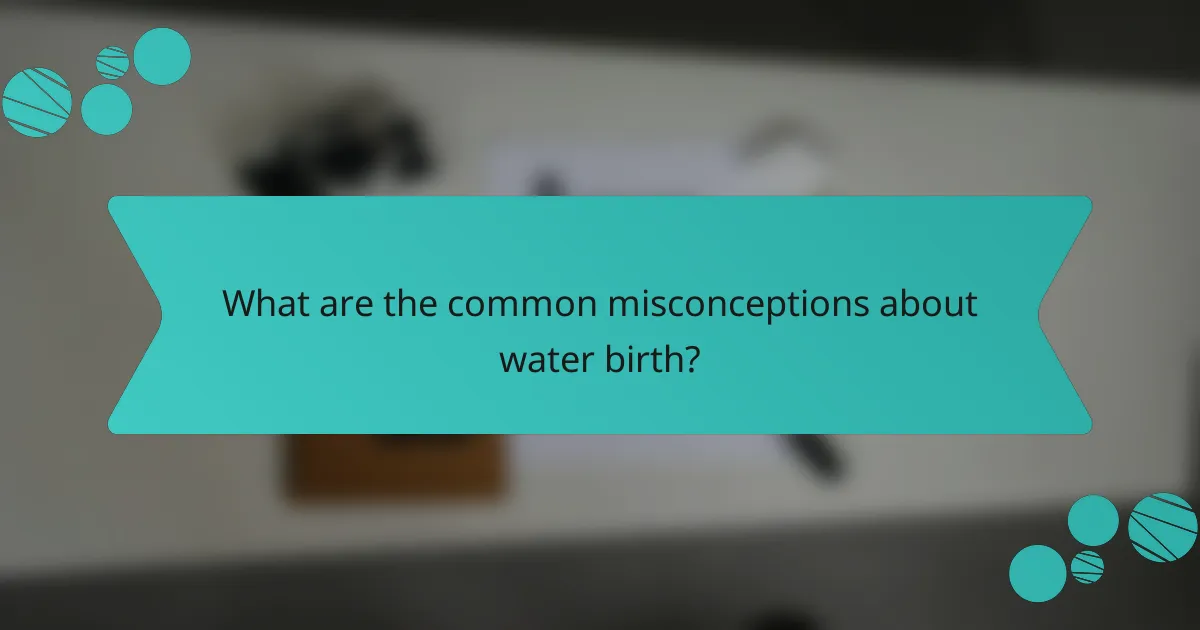
What are the common misconceptions about water birth?
Many people believe that water birth is universally safe and beneficial, but misconceptions can lead to misunderstandings about its suitability and risks. It’s essential to consider individual circumstances and consult healthcare professionals when evaluating water birth options.
Water birth is not safe for all mothers
Water birth may not be appropriate for every mother, particularly those with specific medical conditions such as high blood pressure, certain infections, or complications during pregnancy. Each case should be assessed individually, taking into account the mother’s health and the baby’s condition.
Healthcare providers often recommend thorough evaluations before opting for water birth. Factors like gestational age and the presence of any complications can influence safety and outcomes. Always discuss your options with a qualified practitioner to ensure the best decision for you and your baby.
Water birth leads to higher infection rates
There is a common belief that water birth increases the risk of infections for both the mother and the baby. While some studies suggest a slight increase in certain infections, the overall risk remains low when proper hygiene practices are followed. Maintaining clean water and ensuring the birthing environment is sterile are crucial steps.
To minimize infection risks, healthcare providers typically recommend using filtered and heated water, as well as ensuring that all equipment is sterile. Mothers should also be screened for infections prior to labor. Following these guidelines can help maintain a safe environment for water birth.
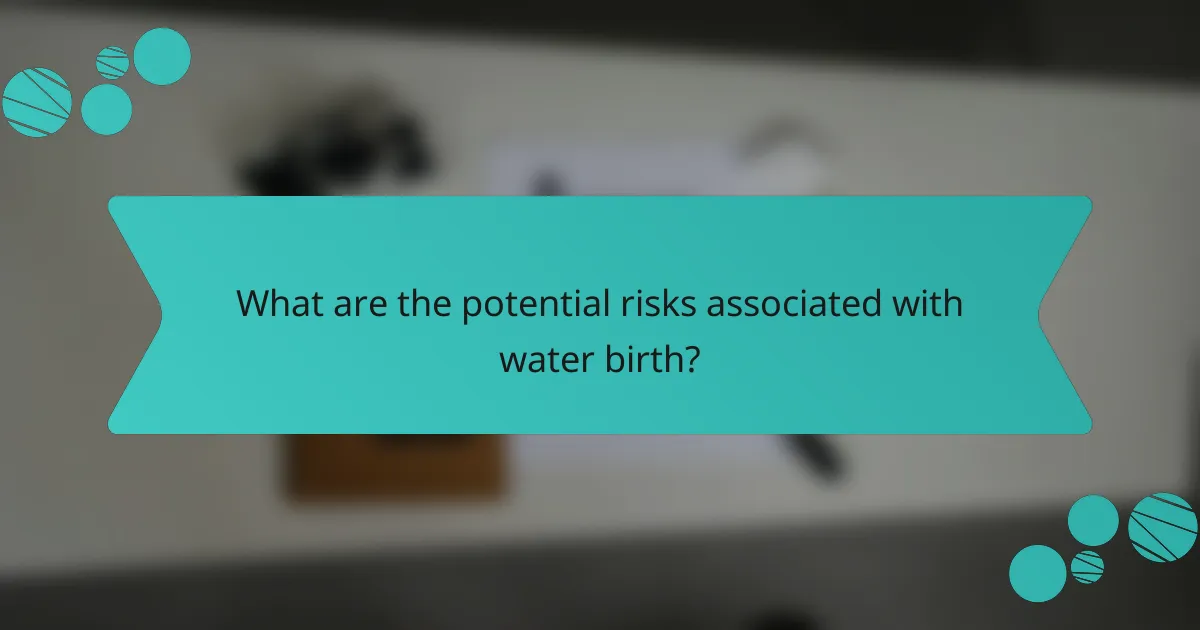
What are the potential risks associated with water birth?
Water birth can present several risks that expectant parents should consider. While many women find it beneficial for pain management and emotional comfort, potential complications can arise during the process that may affect both the mother and the baby.
Possible water aspiration for the baby
One significant risk of water birth is the possibility of water aspiration, where the baby inhales water instead of air during delivery. This can occur if the baby is submerged during the birth process, leading to respiratory issues. To mitigate this risk, it is crucial for the birthing team to monitor the baby’s position closely and ensure that the head emerges from the water before the body.
Inadequate monitoring of labor progress
Another concern with water birth is the potential for inadequate monitoring of labor progress. In a water birth setting, traditional methods of monitoring contractions and fetal heart rates may be less accessible. This can lead to delays in identifying complications. To address this, caregivers should establish clear protocols for monitoring and be prepared to assist the mother out of the water if necessary for more thorough evaluations.
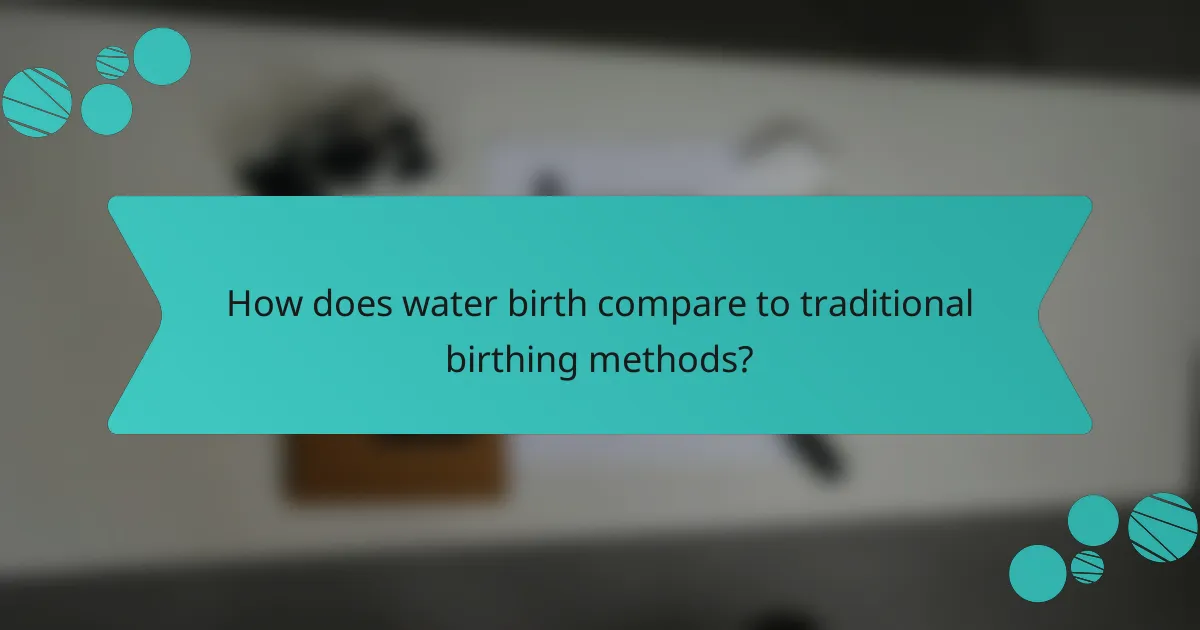
How does water birth compare to traditional birthing methods?
Water birth offers a unique alternative to traditional birthing methods by providing a soothing environment that can enhance pain management and emotional comfort. Unlike conventional deliveries, which typically occur on a hospital bed, water births take place in a tub filled with warm water, allowing for a more natural birthing process.
Pain Management
Water birth can significantly aid in pain management during labor. The buoyancy of the water helps reduce pressure on the body, which can alleviate discomfort and promote relaxation. Many women report lower levels of pain and a reduced need for pain relief medications when laboring in water.
Warm water can also enhance blood circulation and decrease muscle tension, contributing to a more comfortable experience. It’s advisable to discuss pain management options with a healthcare provider to determine the best approach for individual needs.
Natural Birthing Process
The natural birthing process is emphasized in water births, as the warm water can facilitate a smoother transition for the baby from the womb to the outside world. This method often encourages a more instinctive approach to labor, allowing mothers to move freely and adopt various positions that feel comfortable.
It’s essential to ensure that the water temperature is maintained within a safe range, typically between 36-37°C (97-98.6°F), to support both maternal and fetal well-being. Expecting mothers should consult with their healthcare providers to understand the guidelines and best practices for a safe water birth.
Emotional Comfort
Emotional comfort is a significant benefit of water birth, as the warm water can create a calming atmosphere that reduces anxiety. Many women find that the soothing environment helps them feel more in control during labor, which can positively impact their overall experience.
Incorporating supportive partners or doulas into the water birth can further enhance emotional comfort. It’s crucial to prepare mentally and physically for the experience, discussing any concerns with a healthcare professional to ensure a supportive environment during labor.
